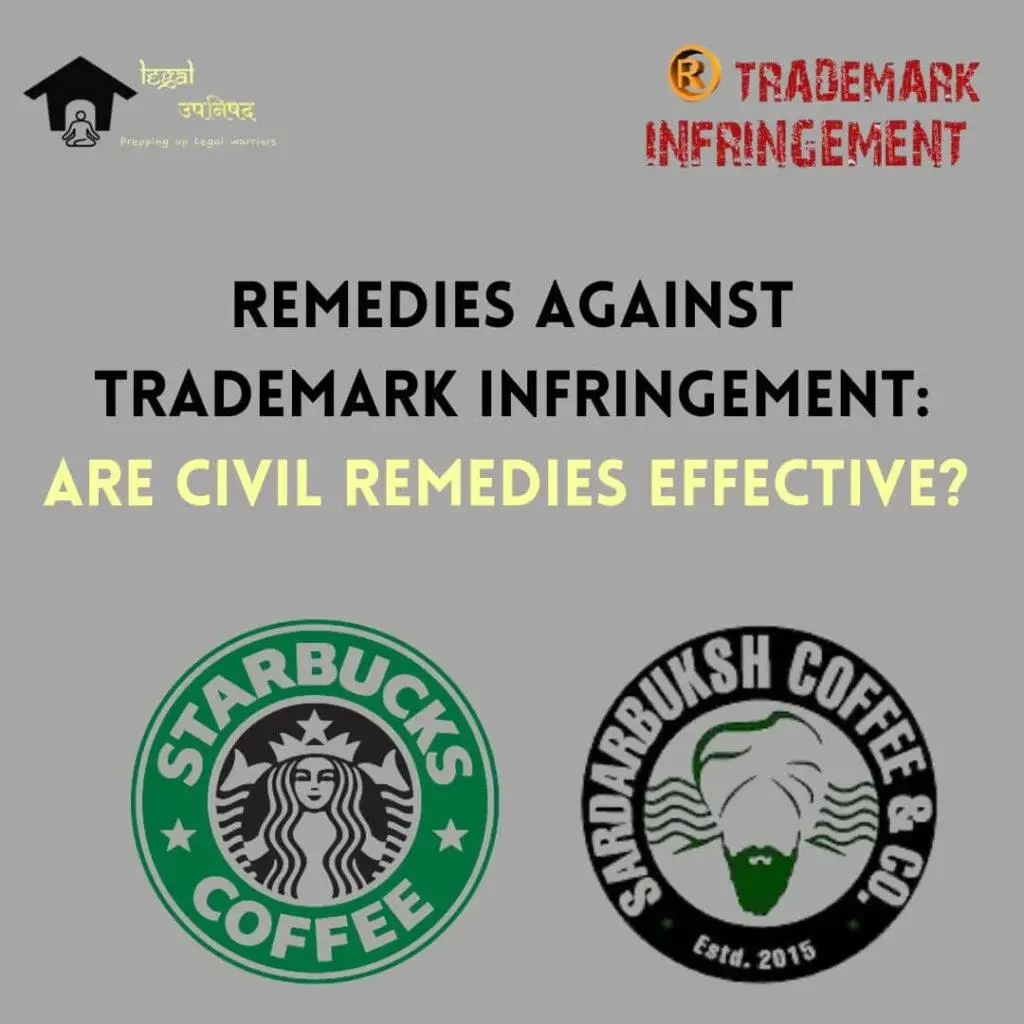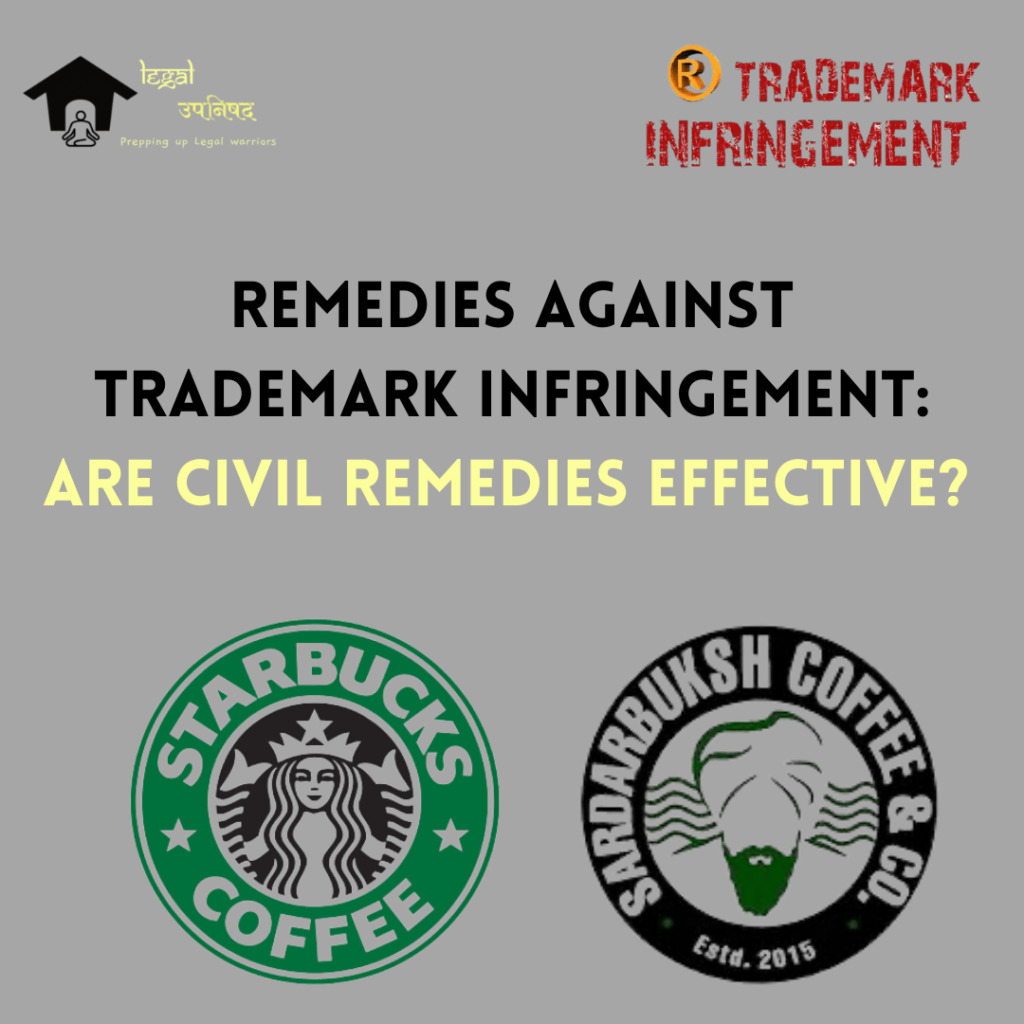This article on ‘Trademark Infringement: Everything you need to know’ was written by Shruti, an intern at Legal Upanishad.
Introduction
This article will focus on what is a trademark, and trademark infringement remedies against trademark infringement, and it will also discuss if civil remedies are effective. It can be anything and they get to decide how, and where it can be used or who gets to use it, and who can get profits from it. The creators to keep their intellectual property safe from misuse. Law plays a role in protecting it if it is made public. Legal protection is given by patent, copyright, or trademark. Under trademark things like business names, logos, slogans, etc. can be covered.
What is a Trademark?
A trademark is a logo, number, word, or combination of words, phrases, or symbols. It can be used by an individual, legal identity, or business organization. It is used to distinguish one’s product or symbol from other people’s products or symbols so that they can’t copy it. Only the people who created that product will have exclusive rights to it. No one can make anything similar or identical to it. Law can protect one’s trademark if it is registered. A specific symbol is used for the trademarks that are registered to distinguish itself from others. This helps the consumers to recognize the source, and quality and make the right decision to purchase.
What is Trademark Infringement?
The trademarks are protected under Trademarks Act, 1999. Section 28 of this act talks about rights conferred by registration, section 29 describes trademark infringement, which deals with the unauthorized use of a trademark. It’s an infringement when anyone uses a mark that is not his and the logo or name is very similar to the one who actually created it. It is very similar to the extent that it confuses consumers and creates a false impression that they can’t even differentiate things properly.


Remedies against Trademark Infringement
Remedies are the solution for the infringement of both registered and unregistered trademarks. Trademark law signifies criminal, civil, and administrative remedies to fight against infringement. These remedies can be adopted by the facts and circumstances of the case at hand.
Civil Remedies Against Trademark Infringement
Civil remedies can be enforced by filing a suit in a competent court. These are the forms of relief available:
Injunction:
The injunction means stopping a person from doing certain activities which bring danger to a property being wasted, damaged, or wrongfully sold in execution of a decree. It is a restriction of a person from doing things that he is not authorized to do.
Perpetual injunction:
It is a final order that restrains the defendant for all times, totally, from doing any act which infringes the right of the other person.
Temporary injunction:
Discretionary relief is offered to the plaintiff which prohibits any act of a party until the final order is passed.
Anton Piller order:
This allows the plaintiff to enter into the premises of the defendant and inspect relevant documents and articles and also allows them to make copies or remove them. There are few conditions to make such an order. Firstly, there should be strong prima facie in favor of the plaintiff or if such order is not passed there might occur irreplaceable damage or there must be strong proof that the defendant would clear the evidence by destroying the documents or articles. There is no need for the notice of the application to the defendant.
Marvena injunction:
This order freezes the defendant’s assets until the trial ends. This can be applied if the assets of the defendant get canceled, and then the judgment against him can be unenforceable.
Damages and account of profits:
Damages can be monetary compensation, given to the aggrieved person as the trademark he owned has been ceased by an unauthorized person which led him to suffer losses. The damages will be granted after looking into the actual loss of the owner. The compensation can be more than the loss suffered by the person.
In the account of profits, the infringer is required to give up the gains which he took from the owner. The plaintiff can be granted either damages or an account of profits but not both.
Destruction and sealing of material:
The court may appoint a local commissioner to seal the infringed material and account. It might order to destroy the infringed materials completely or to deliver the products that are infringed before the court.
Recovery of reputation:
To restore the reputation of the business of the infringed person, the court may order the infringer to take a few measures. This can be done through advertising his apology or doing something that will bring back the faith of the consumers.
CRIMINAL REMEDIES Against Trademark Infringement:
As trademark infringement is a cognizable offense, police can file FIR and start an investigation. There are few criminal remedies for trademark infringement. They are:
- Section 103 enforces a period of six months of imprisonment which can be extended to three years,
- and Section 104 lists a fine of fifty thousand rupees which can be extended to two lakhs.
- While Section 105 talks about the inflating version of punishment provided under this act.
ADMINISTRATIVE REMEDIES Against Trademark Infringement:
There are a number of administrative remedies available against trademark infringement. The administrative remedies against trademark infringement are as follows:
Opposition against a similar mark:
Any person who has been infringed and believes that the published trademark creates confusion among the consumers. Then can oppose the mark within four months from the date of publication. After both parties submit their evidence decision is taken if the trademark is registered.
Rectification of a registered mark:
An aggrieved party can file for the removal of the registered trademark. If he believes that the mark is not supposed to be in the register. A mark is registered wrongly even if it’s not used, expired, or registered without the knowledge of the mark which was already present. In such cases, a procedure given by the act can be followed to rectify it.
Export or import:
It prevents the export or import of good that has infringed trademark.
ARE CIVIL REMEDIES EFFECTIVE Against Trademark Infringement?
Among the three remedies, civil remedies are one of the important ones and have an effective form of remedy available. It clearly, helps the person who is infringed on. Also, gets him justice which makes people believe in the law and file a suit in court. Recovering the damages is the main objective of civil litigation. Legal action is initiated as soon as possible against the infringer. In order to establish the seriousness of the rights carried by the trademark holders.
Nowadays courts have started imposing damages as financial penalties to make sure that intellectual property rights are not violated. But, awarding high damages is not the goal, as recovering actual damages from the infringer is more important. The court has become liberal in granting large damages than recovering the sum from the infringer. This weakens the effectiveness of the remedy considerably.
SUGGESTIONS:
- Simply granting high damages is not enough for this infringement to stop. Filing a suit for trademark infringement is a long and expensive process. Not everyone who infringed did it with knowledge, some do it by mistake. So, awareness should be made among people that, creating something similar to someone else’s mark is against law and is punishable.
- Though it is not compulsory to register their trademark under the law. There are remedies for both registered and unregistered trademarks. It is suggestible for one to register it as law can help them recover proper damages without much difficulty.
CONCLUSION:
Remedies for infringement of a trademark are available in three forms. They are civil, criminal, and administrative. These remedies are available only for registered trademarks. People who have their trademarks registered, get proper damages or profits. Whichever is applicable without much difficulty when compared to unregistered trademarks. As infringing a trademark is cognizable offense police can file an FIR and start an investigation as soon as possible. Along with direct infringement, indirect infringement is also there.
Though there are no provisions for this, it is still liable under the principle of universal law. Civil remedies to be more effective could concentrate more on recovering the proper sum from people. We could conclude by saying that there are proper remedies available. People could register their trademarks and recover their damages or profits from infringers.
REFERENCES:
- Oishika Banerji. (2020, May 29). Remedies available for Trademark Infringement. Retrieved: https://blog.ipleaders.in/remedies-available-for-trademark-infringement/
- Essenese Obhan & Taarika Pillai. (2020, July 13). Selecting the best remedy for Trademark Enforcement in India. Retrieved: https://www.mondaq.com/india/trademark/965594/selecting-the-best-remedy-for-trademark-enforcement-in-india
- Prachi Prajapati, C.S. (2018, April 25). Trademark Infringement and Remedies available to the owner. Retrieved: http://www.elgalwiz.in/blog/trademark-infringment-and-its-remedies
- Ritik Kumar. (2020, December 20). Trademark Infringement and its Remedies. Retrieved: https://lawcirca.com/trademark-infringement-and -its-remedies/
- Sakshi Sharda. (2020, April 21). Trademark Infringement: Meaning, Types, and Remedies. Retrieved: https://corpbiz.io/learning/trademark-infringement-meaning-types-and- remedies/
- [Lawnotes4u]. (2020, June 5). Remedies for Infringement and Passing off of trademark || Trade Mark Act, 1999 || [Video File]. Retrieved: https://www.youtube.com/watch?v=zgZ7HKuOQJo&ab_channel=Lawnotesfor4u


Comments are closed.